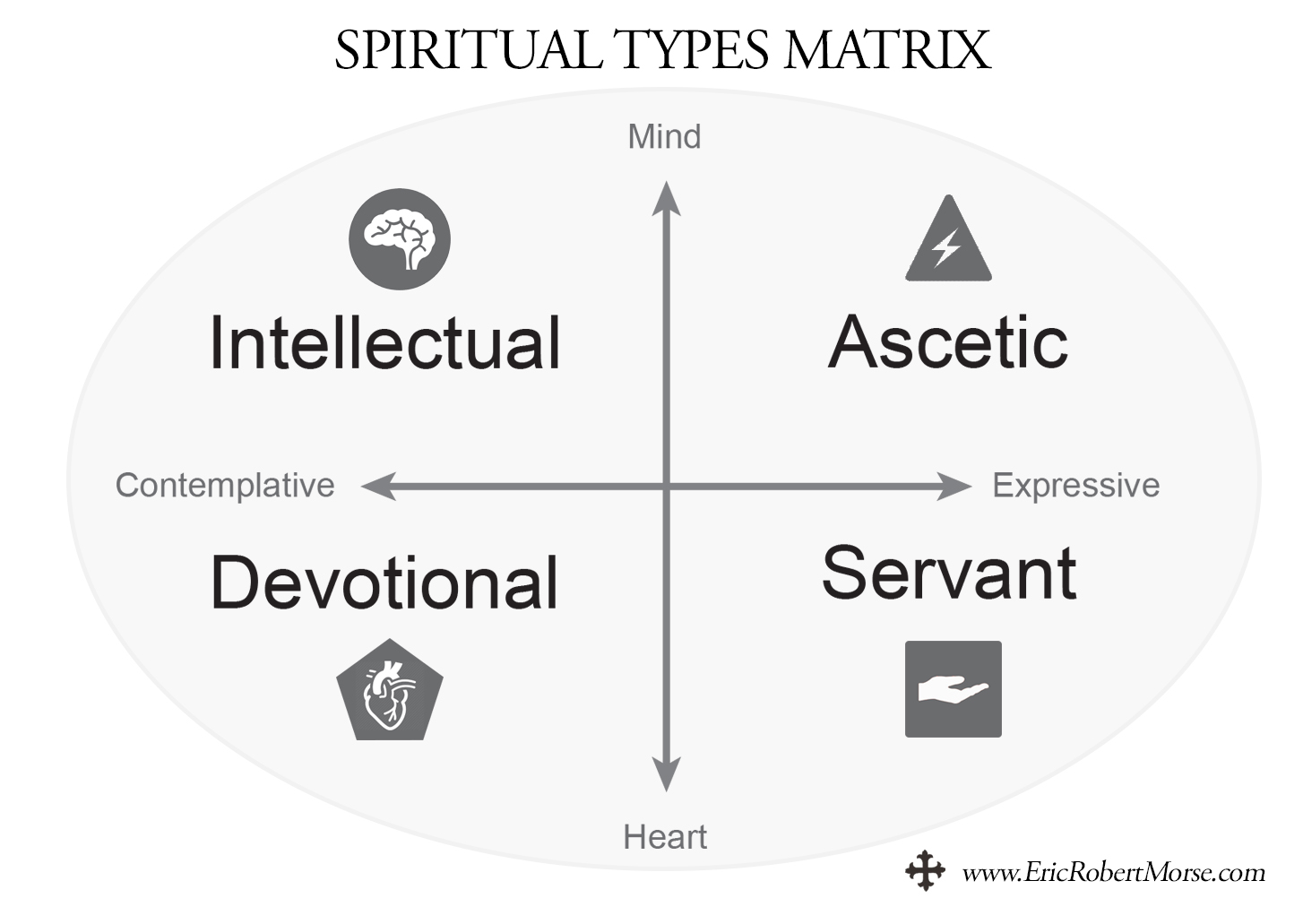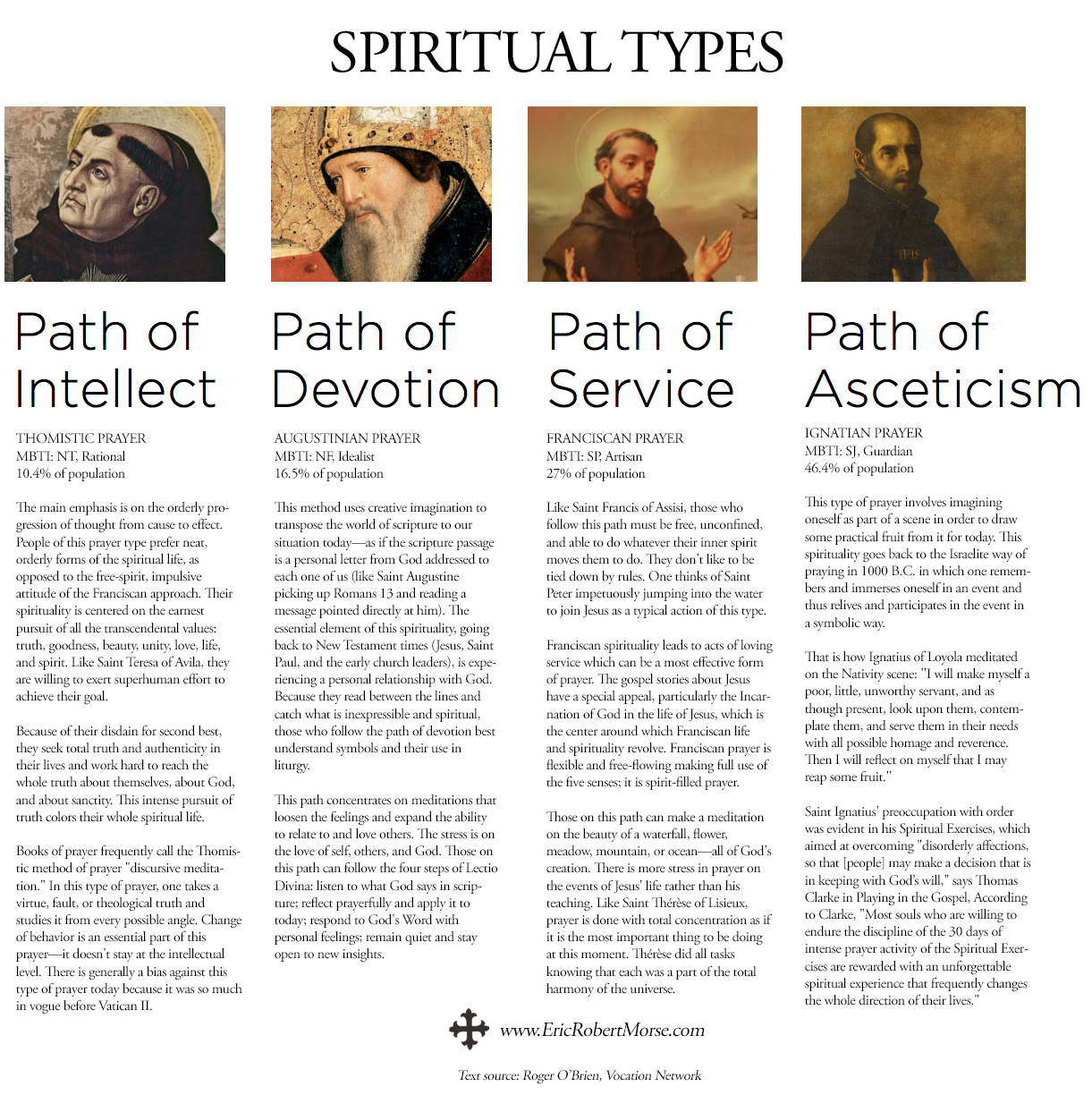Spiritual Types
I was at Mass with a friend one day and, when I looked over during the Eucharistic Prayer, I noticed she was weeping. Afterward I asked her if she was upset. “No,” she said, “the opposite—it’s when you’re crying that you really know that you’re praying.”
Now, if you know me, you know that I’m not the strongest weeper in the world. I don’t even cry at funerals. So, I wondered, does that make me a bad prayerer? I asked my friend, “What if I am not compelled to cry during prayer?”
“It probably isn’t a strong form of worship,” she said.
This was a little unsettling. “Perhaps,” I said, “some people are better equipped for weeping during prayer, and other people are better equipped for other, non-emotional responses to prayer.”
She said that kind of thinking was blasphemy and that was the end of the conversation. Well, to paraphrase Patrick Henry, if this be blasphemy, then make the most of it!
An Inconvenient Youth
I grew up going to a modernist church. Rod Dreher might call it Our Lady of Pizza Hut because I think they used the same architect.
It was designed to appeal to my generation—it was community-oriented, had cheerful folksy guitar music, and accessible homilies. But I never felt at home there. Plenty of people loved it, but it didn’t speak to me and, as a result, I never really was interested in the faith.
It wasn’t until after college that I finally came to understand. I was living in San Diego, and someone recommended I go to The Mission there. Now, I didn’t want to go because that’s where all of the old-timers went, and I wasn’t an old timer. But I didn’t have anything else to do on a chilly summer day, so I went. And it changed my life.
I might be eighty years old because I loved absolutely everything about it. There was history, there was beauty, there was a choir of angels, there was fire and brimstone from the pulpit—this was what was missing in my previous church experience—this was what it was all about. People have talked about Mass as being Heaven on earth. Well, I finally understood what they meant when they said that. I haven’t missed a Sunday Mass since.

How could it be that a church that was basically designed for the youth with its Pizza Hut architecture, community, and guitars had no appeal for me, and yet an old church with old traditions and old people actually spoke to me? The answer, as I’ve come to understand it, lies in this notion of spiritual types.
Everyone knows about personality types—a psychological theme that has been consonant with school, business, and relationship psychology for decades now. The premise is hard to deny: Individuals reliably display traits and characteristics, and, given the right testing, we can understand and predict a person’s behavior. The fact is people are different, they experience the world differently, and they express themselves differently. Shouldn’t this apply to the spiritual realm as well?
Some may well find spiritual enlightenment through tearful prayer, but others might be more inclined to find that spiritual enlightenment through study, song, or art. Some might be like Thérèse of Lisieux, and some might be like Jean Darc.
I was beginning to see the validity in spiritual types.
All Thoughts and Actions a Prayer
It was then that I heard something revelatory. In his First Letter to the Thessalonians, Paul says something absolutely paradigm-shifting: “Pray without ceasing.”
Now, there are two ways to read this verse. The first is to view it as a nice ideal, unobtainable, but a good stretch goal. The second is to say, no, he meant what he said—we should actually pray without ceasing. But if he meant it, then wouldn’t it mean isolating oneself and not eating or sleeping or working at all? How could one survive?
To read it in the second way is to take a completely different view of prayer and life in general. We tend to think that prayer is a detached exercise, where you have to sit silently and repeat the lines of a saint or angel. But that’s not the only way to pray. Praying is communicating with God, and not only are there innumerable ways to communicate, so too can all of our actions as human beings be considered a form of communication.
This notion was made clear to me when I overheard someone complaining about a certain issue he was suffering through. His companion said “Offer it up!” The idea is that you can channel that pain into a prayer that ideally helps you understand the world and God’s will better.
Indeed, I realized that everything we do can be offered up to God as a kind of prayer. There is nothing so base or minimal that couldn’t possibly be done better or in a more godly manner if we were to perform it more conscientiously. When one is at work, struggling on a project—offer it up. When one is heading out for a run—offer it up. When one is sitting down for a meal—offer it up.
One recalls the old saw where a young seminarian asks his elder if he can have a beer while praying. The priest says “Of course not—that would be blasphemy!” But a more clever seminarian followed to ask if he could pray while having a beer, to which the response was “Of course—pray any chance you can get!”
This is how we can live up to Paul’s lofty goal—it’s not that we need to drop everything in our lives and focus just on Rosaries and meditation, but that we need to infuse the prayerful meditation into our day-to-day activities. We don’t have to starve to pray without ceasing, we just have to include God in our every thought and action.
If we are to take this thought to its natural conclusion, we find that prayer is not some departure from who we are, but a natural outgrowth of who we long to be. And, ultimately, since we all cannot be the same person, we find that prayer must take different forms.
As Paul makes clear in his First Letter to the Corinthians:
To each individual the manifestation of the Spirit is given for some benefit.
To one is given through the Spirit the expression of wisdom; to another the expression of knowledge according to the same Spirit;
to another faith by the same Spirit; to another gifts of healing by the one Spirit;
to another mighty deeds; to another prophecy; to another discernment of spirits; to another varieties of tongues; to another interpretation of tongues.
This doesn’t make us any less prayerful or any less Christian.
There are different kinds of spiritual gifts but the same Spirit;
there are different forms of service but the same Lord;
there are different workings but the same God
who produces all of them in everyone.
To each individual the manifestation of the Spirit
is given for some benefit.As a body is one though it has many parts,
and all the parts of the body, though many, are one body,
so also Christ.
For in one Spirit we were all baptized into one body,
whether Jews or Greeks, slaves or free persons,
and we were all given to drink of one Spirit.
My friend was tempted to believe that because she was moved to such a powerful connection while weeping over the Eucharistic Prayer that everyone must seek and obtain the same experience. But that is to deny the very sensible reality that different people will connect with God in different ways. And, despite our different approaches, the destination is the same. It is not the approach that unites us but that ultimate destination.
Nor should this be disconcerting at all. Indeed, diversity is what has made the Catholic Church universal in the first place. It is why there are so many orders within the Church—it could be said one for each spiritual type. To be sure, some of our greatest saints have been dissatisfied with the practices and conventions before them, and sought out to create a new way and ended up reviving the Church as a result.
So next time you’re praying and someone tells you you’re doing it wrong, tell them to consult with St. Francis or St. Dominic or St. Ignatius Loyola or Mother Theresa. They’ll explain that a revolution is always illegal until it succeeds. And an unconventional method is often viewed as heresy until it becomes dogma.
The Four Spiritual Types
So, what are the spiritual types? And how can we learn more about them?
Similar to the work of mid-20th-century Episcopal priest Urban T. Holmes, we can break down a person’s spiritual approach along two axes: Mind/Heart and Contemplative/Expressive. Doing so, we get four quadrants in which most people will fall: Intellectual, Devotional, Servant, and Ascetic as shown in the Spiritual Types Matrix.

Just as there are four main personality types, there are four main approaches to spirituality. The Vocation Network has a nice quick test you can take to determine yours and a summary of each type. They also translate quite nicely from the Myers-Briggs Keirsey Temperaments, The Big Five, and other personality typologies.





